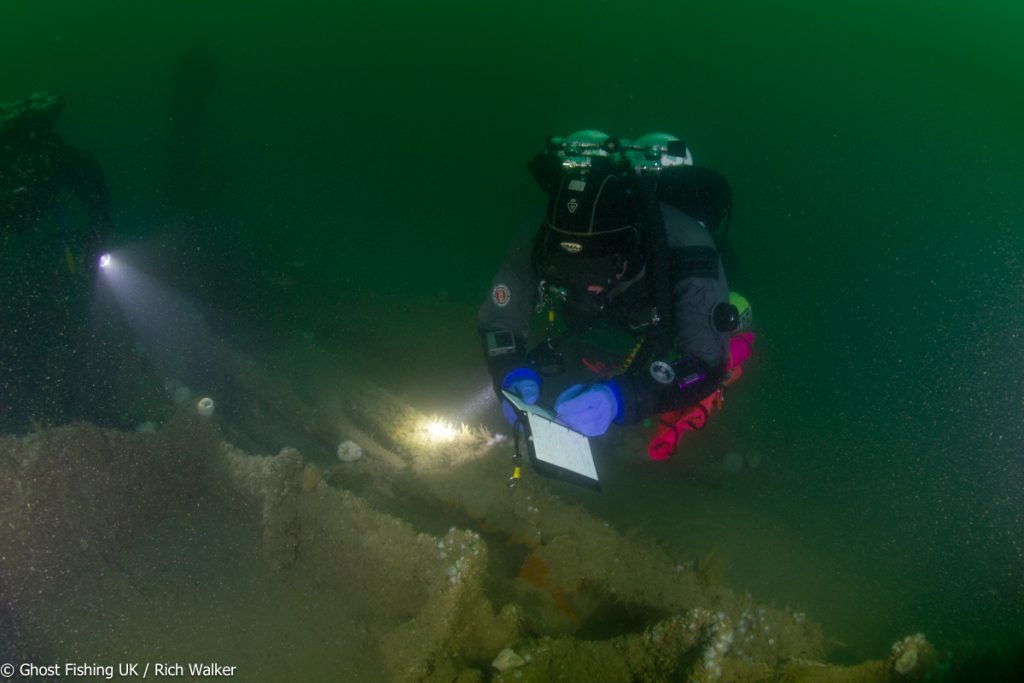Image: Rich Walker
On Wednesday 24th May, a Ghost Fishing UK team assembled in Brighton on the south coast of the UK to continue an ongoing project to clean up the wrecks in the region. We had some existing surveys of the wreck of the Pentrych, and also some new information on lost gear yet to be surveyed. Here, Ghost Fishing UK’s chairman, Rich Walker, tells the story.
The Pentrych is an old friend to us. We’ve been working to remove some trawl nets from the engine area for at least a year now. It’s well tangled, but each visit pulls more of it off of the wreck There were also a few old lobster pots that hadn’t been recovered. Fred, Jason, Rich and Tom set to work doing what we call a litter pick. This is where we lift “loose” items like pots to the surface. It’s relatively easy work, we simply attach a lifting bag to the gear and send it to the surface. Anything more complex than that needs a three-person team and a more rigorous approach, especially to the safety and teamwork. A few pots, and some scraps of net made it to the surface and will not become microplastics, or catch any wildlife again. So a good dive in all.
The second dive of the day was on a reported of a large pile of lobster pots that had perhaps been lost in a storm. We’d be diving in a current, so we dropped into the water upstream of the reported location and drifted onto Black Reef. Despite a very good look round, and following an old pot line for a hundred metres or so back into the current, neither team could find any trace of lost fishing gear at all. That’s not to say it isn’t there, but we need to get some more tangible location data from our source. We’ll be back if we can zero the marks a little better.
On Thursday, we were joined by Jack who dropped into the dive team effortlessly as always. Also on the boat today was Sophie Atkinson from Sussex Wildlife Trust. She was keen to see the work we do as part of our ongoing work together in educating the public about what’s beneath the surface of our seas.
The site was a new one to us – the wreck of the Lancer II. She was a small trawler sunk in a collision in 1918. The teams surveyed this small wreck in less than thirty minutes, leaving a little time to start recovering some easy pickings. A small piece of net was removed from the bow by Rich, Jason and Jack, and Fred and Tom sent a lobster pot or two up to the surface.
The second dive was again a report of a lost trawl. The tide was again running, and the team found it difficult to navigate in the current and across a featureless sandy bottom. However there was a trawl net, heavily buried in the sand. We estimated that it would take multiple days of work to remove it, and as it was not catching any life we decided to leave it for another time.
On Friday, we were joined by Joe, Alex and James, but sadly Jack had to head back home for a wedding anniversary or some such event! The plan was to do a long dive on the Lancer II and remove as much as possible. The survey had shown that there was several days work here, so we were keen to make a start. Fred and Tom worked along the starboard side of the wreck, removing several old lobster pots, as did Jason and Alex. Joe, James and Rich worked on the bow area, where there is a large trawl net entangled in all of the deck machinery and extending down into the fo’castle. It also continues along the deck towards the stern, so a big job. Nearly 80 kg of net was removed, but there’s plenty more remaining for another trip. The pot teams also recovered at least four intact pots, and a couple of heavily damaged ones as well.
For the three-day project, we were fantastically supported by Steve and Caroline of Channel Diving. They always go the extra mile when it comes to working with us, and they always get involved with the landing of the retrieved gear back onto shore. Without them, much of this work could not be done, so we’re always very grateful for their support.

